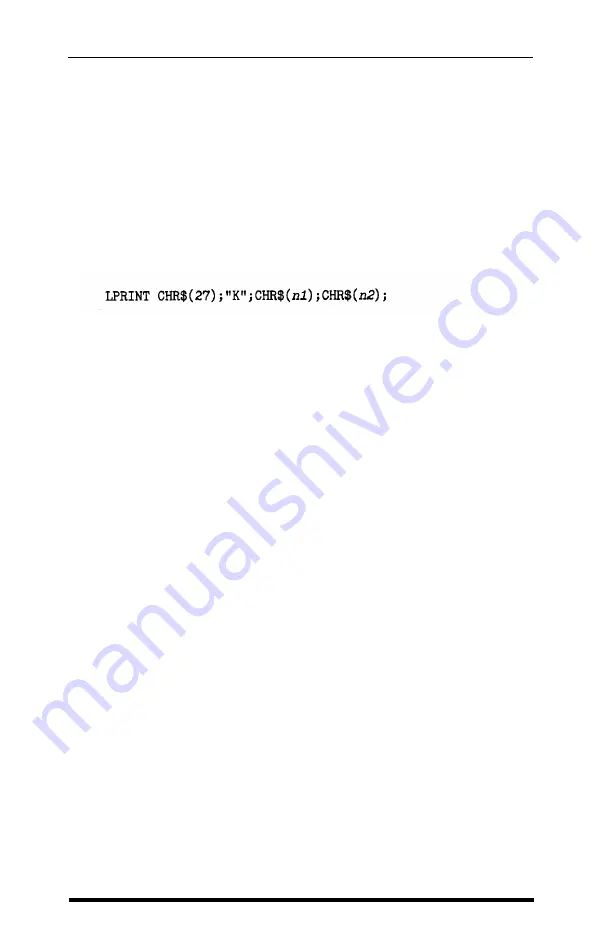
The graphics command format
There are several different graphics commands giving different
horizontal dot densities and printing speeds. Because the format is
almost the same for all the commands, however, the example here
keeps things simple by using only the singledensity graphics
command, ESC K. In single-density graphics, there are 60 dots per inch
horizontally
The command to enter singledensity graphics mode is ESC K
nl n2.
In BASIC the command is given in this format:
ESC K specifies single-density graphics, and the next two numbers
(nl
and
n2)
specify the number of columns reserved for graphics.
Column reservation numbers
Even in single-density graphics mode, one 8-inch line can
accommodate 480 columns of graphics; in quadruple-density, almost
2000 columns can fit on the same 8-inch line. Since the printer does
not use decimal numbers larger than 255, the graphics commands use
two numbers for reserving columns.
Because the commands are set up for two numbers, you must supply
two even if you need only one. When you need fewer than 256
columns, it is easy to determine
nl
and
n2:
nl
is the number of
columns you are reserving and
n2
is zero. For example, to send data for
200 columns of graphics,
nl
is 200 and
n2
is 0.
For more than 256 columns of graphics data,
n2
is the number of
complete groups of 256 columns, and
nl
is the number of columns to
complete the line. For example, to send 1632 columns of graphic data,
nl
is 96 and
n2
is 6 because 96 + (6 x 256) = 1632.
You can calculate both
nl
and
n2
by dividing the total number of
columns by 256. The quotient is n2 and the remainder is
nl.
If you are
using a programming language with MOD (modulus) and INT (integer)
functions, you can use the following formulas, in which
n
is the total
number of columns.
nl = n
MOD 256
n2 = INT
(n/256)
Graphics and User-defined Characters
6-5
Summary of Contents for EX-1000
Page 1: ......
Page 11: ......
Page 29: ...1 18 Setting Up the Printer ...
Page 38: ......
Page 46: ...3 8 Using the EX with Application Programs ...
Page 51: ......
Page 57: ...5 6 EX Printer Features ...
Page 76: ......
Page 81: ...Command Summary A 5 ...
Page 82: ...A 6 Command Summary ...
Page 121: ......
Page 123: ...Table B 1 Epson mode characters B 2 Character Tables ...
Page 124: ...Table B 1 continued Character Tables B 3 ...
Page 125: ...Table B 1 continued B 4 Character Tables ...
Page 126: ...Table B 1 continued Character Tables B 5 ...
Page 127: ...Table B 1 continued B 6 Character Tables ...
Page 128: ...Table B 1 continued Character Tables B 7 ...
Page 129: ...Table B 1 continued B 8 Character Tables ...
Page 133: ...Table B 4 IBM printer emulation mode characters B 12 Character Tables ...
Page 134: ...Table B 4 continued Character Tables B 13 ...
Page 135: ...Table B 4 continued B 14 Character Tables ...
Page 137: ...Table B 4 continued B 16 Character Tables ...
Page 139: ...Table B 4 continued B 18 Character Tables ...
Page 151: ...D 8 Problem Solving and Maintenance ...
Page 157: ...E 6 Defaults and DIP Switches ...
Page 172: ......
Page 173: ...G 8 Technical Specifications ...
Page 183: ...IN 4 Index ...
Page 184: ...Quick Reference ...
Page 186: ......
Page 187: ......
Page 188: ......
Page 189: ......
Page 190: ......






























